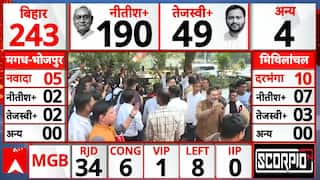(Source: ECI | ABP NEWS)
Household Food Spending Drops Below Half Since 1947: Report
"It is the first time in modern India that average household spending on food is less than half the overall monthly spending of households and is a marker of significant progress," the report said

For the first time since 1947, food expenses account for less than half of the average household's total monthly spending in India, according to a recent paper released by the Economic Advisory Council to the Prime Minister (EAC-PM). The report, titled "Changes in India's Food Consumption and Policy Implications: A Comprehensive Analysis of Household Consumption Expenditure Survey 2022-23 and 2011-12," highlights significant shifts in India's food consumption patterns.
The paper comprehensively analyses the Household Consumption Expenditure Survey 2022–23 and compares it with 2011–12.
The paper reveals that the proportion of household expenditure dedicated to food has notably decreased across both rural and urban areas throughout all states and Union Territories. This trend highlights a broader transformation in how Indian households allocate their budgets.
"It is the first time in modern India (post-independence) that average household spending on food is less than half the overall monthly spending of households and is a marker of significant progress," the report said.
The paper notes a significant increase in the average monthly per capita expenditure for households across rural and urban areas in all states and Union Territories of India. While the overall rise is considerable, the extent of the increase varies by state and region. For instance, in rural areas, West Bengal experienced a 151 per cent growth in consumption expenditure from 2011-12 to 2022-23, whereas Tamil Nadu saw an approximate increase of 214 per cent. Sikkim recorded a substantial 394 per cent rise in consumption expenditure during the same period.
"Overall, we find that growth for rural households was higher than for urban households, 164 per cent for rural households versus 146 per cent for urban households," the report said.
The paper highlights a significant decrease in household expenditure on cereals within the food category, observed across both rural and urban areas. Notably, this decline has been more pronounced among the bottom 20 per cent of households in these regions.
"In all likelihood, this reflects the effectiveness of the government's food security policies, which provide free foodgrains to large numbers of beneficiaries across all states of the country, with a particular focus on the vulnerable bottom 20 per cent of households," the report added.
The paper suggests that agricultural policies need to expand their focus beyond cereals, as consumption of these staples is declining across all income levels. It also points out that support mechanisms like the Minimum Support Price (MSP), which primarily targets cereal procurement, will have limited benefits for farmer welfare.
The report observes a notable increase in household expenditures on served and packaged processed foods across various regions and income groups. This trend is widespread but particularly pronounced among the top 20 per cent of households and in urban areas.
While food processing is a growing sector and a significant source of employment, the paper warns that the increased consumption of processed and packaged foods could have implications for health outcomes. It calls for further research to assess the nutritional impacts of this rising trend. It suggests that policies need to regulate the nutritional content of these foods and encourage healthier alternatives.
Also Read: Corporate To Content Creator: Bengaluru Man Leaves Rs 54 Lakh Job To Write On LinkedIn
Top Headlines







































